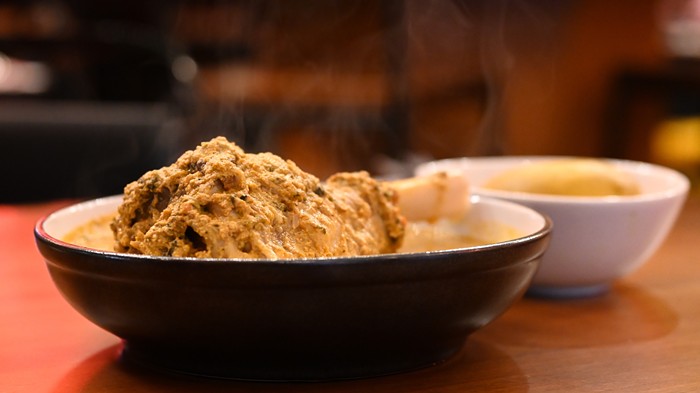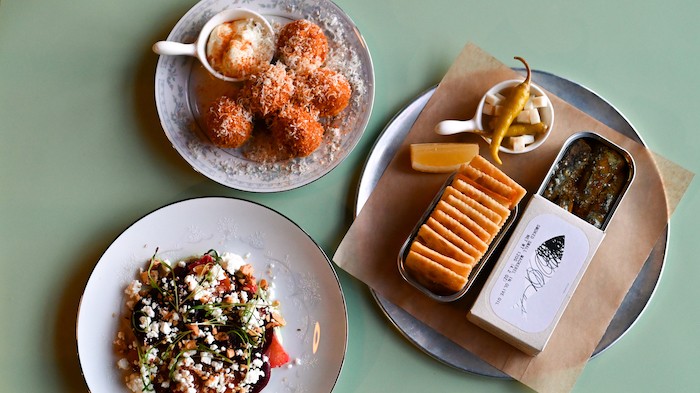
[This is the second in a two-part series on the rotisserie chicken to-go restaurant Rotigo. For part one, click here.—eds]
I have a (chicken) bone to pick.
In response to my review of the restaurant/bar/market Rotigo last week, a small number of folks dismissively scoffed at the price difference between a Rotigo ($34) and Costco chicken ($5). Something about this ruffled my feathers. Everyone is well aware that buying a book off of Amazon is going to be a fraction of the price compared to buying it at Powell’s. And yet, independent bookstores are still here because of our continued patronage and recognition of their importance. And yet, we seem to be having difficulty translating this concept and extending the same grace to independently-owned restaurants.
I hear you, though. I’m a writer, and we aren’t exactly made of money. I recognize that being in a position to spend money in this fashion is one of privilege. But to emphatically and contemptuously discount the myriad factors at play here and point a finger at a sole restaurant speaks to a larger issue in our food systems and the way we interact with them. A (not new) news flash: food prices are only going one direction, and it’s up. The Costcos of the world are WHY we’re paying $34 for the type of quality poultry that Americans were eating as a standard in the times of pre-factory farming.
So on one hand, we have a multinational corporation that in 2020 was ranked by the National Retail Federation as the fifth biggest retailer in the world. Costco’s chickens are artificially priced for a variety of reasons, one of which is that this is a fucking ginormous corporation that can eat the cost of producing this product in other areas of their business. This is one reason, at least, that makes sense and isn’t controversial.
What’s more horrifying are the atrocious conditions these chickens are bred in to ensure demand is met. They’re effectively “bred to suffer,” as Nicholas Kristof writes in this 2021 NYT opinion piece. They live in their own feces, with no fresh air or natural light, sometimes developing “bloody rashes called ammonia burns, which are a poultry version of bed sores.”
Also, ever stop to wonder why a rotisserie chicken, a ready-to-eat product, is cheaper than your average whole, raw chicken? Although Costco has a “dedicated rotisserie chicken program” and doesn’t repurpose overdue meat like some grocery stores, costs are being cut somewhere…which is a big question mark I don’t have time to go full Upton Sinclair on. Aside from the high risk of bacteria and unnatural growth acceleration these chickens are subject to, there’s another health concern to consider. Once bound for the rotisserie, these chickens are pumped full of sodium—about one-fifth the maximum amount of sodium that is recommended for adults, according to Consumer Reports.
Still, I’m not disparaging anyone their Costco chickens. Let’s be real, a $34 chicken isn’t something I’m able to eat with the same regularity as a Costco chicken. But dining out is a luxury any way you slice it, and once in a while, it’s nice (to draw another comparison here) to spring for a fancy arrangement from your local florist instead of that grocery store bouquet. There’s room for both. Plus, if we’re going to talk about price point being a barrier, we must also take into consideration Costco’s barriers to accessibility. Not everyone has a Costco membership, and their locations are often situated in suburban areas that aren’t easily accessible by public transportation.
On the other hand, we have a local, women-owned small business that treats its employees equitably, supports other local small businesses, gives back to the community, and is dedicated to sourcing an ethical product.
At the risk of sounding like this Portlandia skit, Rotigo’s chickens are wholly the opposite of Costco’s birds. Supplied by Cooks Venture, they are verified non-GMO, never given antibiotics, and pasture-raised—which is considered by many to be the industry gold standard as opposed to the USDA’s murky “organic” certification—in a regenerative farming system that is humane for the bird and low-impact on the environment.
As fast food influencer Bill Oakley notes in this Eater article outlining hopes for the industry in 2022: “I hope that the various economic crises, including the supply chain crunch, finally come to an end and allow every worker to be paid a living wage or more as consumers get used to paying a bit more for good food that had been artificially underpriced for quite awhile.” Rotigo is an establishment that has intentionally committed to the business model that Oakley alludes to.
Rotigo owner Cate Hughes and chef Cara Powell are proud of the way the restaurant’s employees are treated. For Powell, getting to work with a female owner whose values aligned with hers has been a career changer. “I have an incredible staff, and haven’t had any issues with staffing shortages,” said Powell. “I make sure that the people who work with me feel cared for and supported, because people are not expendable.” Along with a livable wage, gratuity is shared equally between the front and back of the house. The restaurant also created an employee wellness fund—after a few months of employment, employees will earn a 50 cent-per-hour bonus that is paid out quarterly and intended to “enrich their lives or their family’s lives,” although they are free to use it however they want.
The restaurant has also incorporated a “Round Up & Give” feature on their online ordering system that benefits the BIPOC- and women-led nonprofit Equitable Giving Circle. Once her newly-opened business becomes more established, Hughes hopes to organize monthly events that will incorporate larger fundraising efforts for its community partner. The first date the sommelier-turned-owner is eyeing? La Festa della Donna (International Women’s Day) on March 8, which is “a really big deal in Italy” and an occasion many female-owned culinary businesses celebrate in other cities Hughes has worked in.
In essence, support local when and if you can. (And a friendly reminder: support doesn’t merely stem from patronage.) Your average restaurant owner doesn’t get into this industry to stiff you in hopes of getting rich, they do it out of a passion for food. Behind the scenes of these businesses, there are agonized-over calculations going into designing menu pricing that we usually aren’t privy to. After all, we go to restaurants to eat, not to analyze business decisions. We could all stand to be kinder to local restaurants and their employees at this time, especially when, in addition to running a business, they're crying out for help from the government. No one ever lamented the loss of a Buffalo Wild Wings, but Portland would surely sprint madly—like a chicken with its head cut off—if Fire on the Mountain were to disappear from our dining landscape.


















